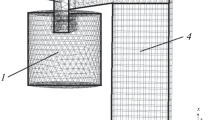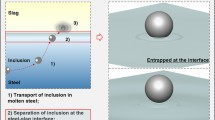Abstract
The paper outlines the process of developing a computer model to predict particle distribution during centrifugal casting using the ANSYS FLUENT 16.0 software module. There are several mathematical models developed to predict the volume distribution of particles. The majority of the models is based on a steady state assumption: these are models describing criteria for repelling particles by a propagating crystallization front and the models calculating critical velocities of absorbing particles by growing dendritic crystals. Some models are aimed at describing the dynamic state of the system or at determining the criterion of capturing non-metallic inclusions by hardening front during centrifugal metal casting. The description of the process for deriving the model, the schematic diagram and geometry, is given. The model preprocessor considers the following phenomena: the two-phase flow, the energy equation, the laminar flow, the introduction of discrete phases (hardening particles), and the melting/crystallizing phenomena. The model considers the interaction between two liquid phases: air and steel melt. The interphase interaction is described using the surface tension equation. Steel grade 12Х18Н10T is used as the base metal. The particles of tungsten carbide, boron carbide and yttrium oxide are introduced as dispersion. The physics and chemical parameters of these substances are considered by the simulator. The process of simulating particle distribution during centrifugal casting using the computational cluster is described using Skif-Ural, which is one of the top 500 most powerful computers in the world. In addition to graphical display, the simulation generates data for coordinates of each particle with the time increment of 0.00001 sec which allows predicting the exact location of each particle at each moment of casting. The results show that the process of centrifugal casting involving introduction of dispersed particles allows obtaining dispersed and hardened metal materials having forecasted distribution of heat-resisting particles.








Similar content being viewed by others
REFERENCES
Guzenkov, S.A., Fedorov, D.N., Rutskii, D.V., and Gamanyuk, S.B., Increasing the structural strength of cast steel by powder modification, Steel Transl., 2010, vol. 40, no. 3, pp. 2894–297.
Korostelev, A.B., Zherebtsov, S.N., Sokolov, I.P., and Chumak-Zhun, D.A., Modification of heat-resistant nickel alloy with a combined inoculator, Metallurgist, 2011, vol. 54, nos. 9–10, pp. 711–713.
Kuzmanov, P., Dimitrova, R., Lazarova, R., et al., Investigation of the structure and mechanical properties of castings of alloy AlSi7Mg, cast iron GG15 and GG25 and steel GX120Mn12, modified by nanosized powders, Proc. Inst. Mech. Eng., Part N, 2014, vol. 228, no. 1, pp. 11–18.
Cao, L., Liu, G., Gu, H., and Liang, Y., Modification of the structure and properties of heat-resistant alloys with the help of nanopowders of refractory, compounds, Proc. Annual Int. Conf. on Manipulation, Manufacturing and Measurement on the Nanoscale (3M-NANO), Xi’an, 2012, pp. 385–388.
Harris, I.R. and Jones, I.P., Grain Boundaries: Their Character, Characterisation and Influence on Properties, London: Maney Press, 2001.
Chumanov, I.V., Anikeev, A.N., and Chumanov, V.I., Fabrication of functionally graded materials by introducing wolframium carbide dispersed particles during centrifugal casting and examination of FGM’s structure, Procedia Eng., 2015, vol. 129, pp. 816–820.
Kivio, M., Holappa, L., Louhenkilpi, S., Nakamoto, M., and Tanaka, T., Studies on interfacial phenomena in titanium carbide/liquid steel systems for development of functionally graded material, Metall. Mater. Trans. B, 2016, vol. 47, no. 4, pp. 2114–2122.
Komshukov, V.P., Cherepanov, A.N., Protopopov, E.V., et al., Influence of nanopowder modification of metal on the quality of continuous-cast bar, Steel Transl., 2013, vol. 40, no. 8, pp. 717–722.
Watanabe, Y., Inaguma, O., Sato, H., et al., Novel fabrication method for functionally graded materials under centrifugal force: the centrifugal mixed-powder method, Materials, 2009, vol. 2, no. 4, pp. 2510–2525.
Chumanov, I.V., Chumanov, V.I., and Anikeev, A.N., Investigating the effect of carbide disperse particles on hardness and wear resistance of experimental materials in cast and deformed conditions, Indian J. Sci. Technol., 2015, vol. 8, no. 34, pp. 1–7.
Zemtsova, E.G., Yurchuk, D.V., and Smirnov, V.M., Creation of heterogeneity on the basis of carbide nanostructures in the volume of metal (iron) matrix for regulation of mechanical properties, Mater. Phys. Mech., 2013, vol. 18, no. 1, pp. 42–52.
El-Hadad, S., Sato, H., Miura-Fujiwara, E., et al., Fabrication of Al/Al3Ti functionally graded materials by reaction centrifugal mixed-powder method, Jpn. J. Appl. Phys., 2011, vol. 50, suppl. 1, art. ID 01AJ02
Han, Q. and Hunt, D., Particle pushing: critical flow rate required to put particles into motion, J. Cryst. Growth, 1995, vol. 152, no. 3, pp. 221–227.
Chumanov, V.I., Chumanov, I.V., Anikeev, A.N., et al., Hardening of the surface layers of a hollow billet formed by centrifugal casting, Russ. Metall. (Engl. Transl.), 2010, vol. 2010, no. 12, pp. 1125–1128.
Wildeaj, G. and Perepezko, H., Experimental study of particle incorporation during dendritic solidification, Mater. Sci. Eng., A, 2000, vol. 283, nos. 1–2, pp. 25–37.
Wang, Q. and Zhang, L., Detection of non-metallic inclusions in centrifugal continuous casting steel billets, Metall. Mater. Trans. B, 2016, vol. 47, no. 3, pp. 1594–1612.
Catalina, A.V., Mukherjee, S., and Stefanescu, D., A dynamic model for the interaction between a solid particle and an advancing solid/liquid interface, Metall. Mater. Trans. A, 2000, vol. 31, no. 10, pp. 2559–2568.
Wang, Q. and Zhang, L., Determination for the entrapment criterion of nonmetallic inclusions by the solidification front during steel centrifugal continuous casting, Metall. Mater. Trans. B, 2016, vol. 31, no. 10, pp. 1933–1949.
Alekseev, I.A. and Anikeev, A.N., Model of the distribution of dispersed particles over the volume of a centrifugally cast billet, Materialy 70-i nauchnoi konferentsii “Nauka YuUrGU” (Proc. 70th Sci. Conf. “Scientific Researches at the South Ural State University”), Chelyabinsk, 2018, pp. 820–826.
Kostenetskiy, P.S. and Safonov, A.Y., SUSU supercomputer resources, Proc. 10th Annual Int. Sci. Conf. on Parallel Computing Technologies (PCT 2016), Arkhangelsk, 2016.
Funding
The work was supported by the Ministry of Science and Higher Education of the Russian Federation within the framework of the Federal target program under the Agreement no. 05.608.21.0276 (the unique identifier is RFMEFI60819X0276).
Author information
Authors and Affiliations
Corresponding authors
Additional information
Translated by V. Vetrov
About this article
Cite this article
Anikeev, A.N., Chumanov, I.V., Alexeev, A.I. et al. Distribution of Simulating Reinforced Dispersed Particles Across Metal Rods. Steel Transl. 50, 605–610 (2020). https://doi.org/10.3103/S0967091220090028
Received:
Revised:
Accepted:
Published:
Issue Date:
DOI: https://doi.org/10.3103/S0967091220090028




